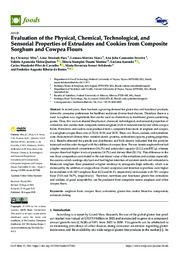Evaluation of the physical, chemical, technological, and sensorial properties of extrudates and cookies from composite sorghum and cowpea flours.
Evaluation of the physical, chemical, technological, and sensorial properties of extrudates and cookies from composite sorghum and cowpea flours.
Author(s): MBA, J. C.; PAES, L. T.; VIANA, L. M.; FERREIRA, A. J. C.; QUEIROZ, V. A. V.; MARTINO, H. S. D.; AZEVEDO, L.; CARVALHO, C. W. P. de; FELISBERTO, M. H. F.; BARROS, F. A. R. de
Summary: In recent years, there has been a growing demand for gluten-free and functional products, driven by consumer preferences for healthier and more diverse food choices. Therefore, there is a need to explore new ingredients that can be used as alternatives to traditional gluten-containing grains. Thus, this work evaluated the physical, chemical, technological, and sensorial properties of extrudates and cookies from composite tannin sorghum (rich in resistant starch) and white cowpea flours. Extrudates and cookies were produced from a composite flour made of sorghum and cowpea, at a sorghum:cowpea flour ratio of 70:30, 50:50, and 30:70. Then, raw flours, cookies, and extrudates were characterized (dietary fiber, resistant starch, proteins, antioxidant capacity, pasting properties, etc.). Results obtained for particle size distribution and bulk density indicated that the particles increased and the color changed with the addition of cowpea flour. The raw tannin sorghum flour had a higher resistant starch concentration (36.3%) and antioxidant capacity (211.2 µmolTE/g), whereas cowpea flour had higher levels of proteins (18.7%) and dietary fiber (20.1%). This difference in the raw flour composition contributed to the nutritional value of the extrudates and cookies, especially the cookies which undergo dry heat and had higher retention of resistant starch and antioxidants. Moreover, sorghum flour presented a higher tendency to retrograde (high setback), which was decreased by the addition of cowpea flour. Overall acceptance and intention to purchase were higher for extrudates with 100% sorghum flour (6.52 and 68.3%, respectively) and cookies with 70% cowpea flour (7.03 and 76.7%, respectively). Therefore, nutritious and functional gluten-free extrudates and cookies, of good acceptability, can be produced from composite tannin sorghum and white cowpea flours.
Publication year: 2023
Types of publication: Journal article
Unit: Embrapa Maize & Sorghum
Observation
Some of Embrapa's publications are published as ePub files. To read them, use or download one of the following free software options to your computer or mobile device. Android: Google Play Books; IOS: iBooks; Windows and Linux: Calibre.
Access other publications
Access the Agricultural Research Database (BDPA) to consult Embrapa's full library collection and records.
Visit Embrapa Bookstore to purchase books and other publications sold by Embrapa.

